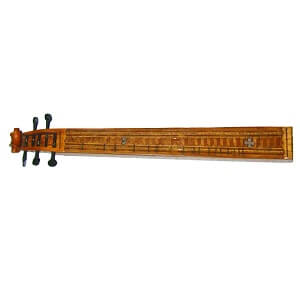Epinette
 In all probability the first drone zithers were made in Northern Germany in the early 16th century. In the following decades and centuries the instrument spread over a large part of the Germanic cultural area and some neighbouring regions. It was also brought to the Vosges, the French mountains along the Rhine, which forms the present border with Germany. In the Vosges the new instrument was called épinette after the other épinette, or spinet in English, an instrument of the harpsichord family that also belongs to the large family of the plucked zithers. Since the late 19th century the folk épinette has often been called épinette des Vosges, to distinguish it from its upper class namesake.
In all probability the first drone zithers were made in Northern Germany in the early 16th century. In the following decades and centuries the instrument spread over a large part of the Germanic cultural area and some neighbouring regions. It was also brought to the Vosges, the French mountains along the Rhine, which forms the present border with Germany. In the Vosges the new instrument was called épinette after the other épinette, or spinet in English, an instrument of the harpsichord family that also belongs to the large family of the plucked zithers. Since the late 19th century the folk épinette has often been called épinette des Vosges, to distinguish it from its upper class namesake.
Like most often with épinette-like zithers elsewhere in northwest Europe, the épinette des Vosges is put on a table and the player is seated. Traditionally the strings are shortened with a stick in the left hand, and plucked with a plectrum in the right hand. Like elsewhere the instrument was played for one’s own pleasure, or to accompany singing and dancing at family parties or gatherings of friends and neighbours at night or on Sunday afternoons. On Sundays the épinette could also accompany religious songs. As it was typically played at home, the épinette was the only folk instrument that was often played by girls and women.
It has been put forward that the épinette was brought to the Vosges by Swedish or German soldiers during the Thirty Years’ War (1618-1648 ), but concrete evidence is lacking. The folk and the upper class épinettes having the same name doesn’t make the interpretation of early written sources easier. In any case, it is certain that the épinette had become commonplace in part of the Vosges by the end of the 18th century. The oldest known player and maker of the instrument, Claude Joseph Vincent (‘le père Vincent’, Val-d’Ajol, 1753-1830) called the épinette ‘l’instrument de nos montagnes’. Val-d’Ajol and its surroundings would remain the core area of the épinette des Vosges tradition. The question remains why exactly the instrument took root in the Vosges, and not at all in the neighbouring Alsace region or elsewhere in Lorraine.